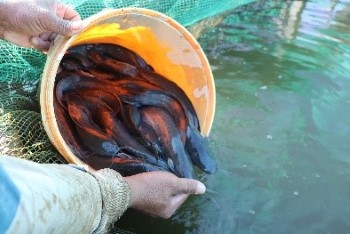June 22, 2021
K-State Works to Advance Cambodian Aquaculture with Soy Feed and Tools

Kansas State University, in partnership with the American Soybean Association (ASA) and others, have collaborated to produce new fish feeding and fish growth charts for Cambodian fish farmers. These vital new tools will assist in the transition from homemade feeds based on rice bran and wild fish to pelleted soy-based feeds manufactured in Cambodian feed mills.
The Commercialization of Aquaculture for Sustainable Trade (CAST) project benefits from K-State’s expertise and work in Cambodia. Cambodia’s private sector and universities work closely with U.S. soybean growers and businesses, as well as academic and non-governmental organizations.
“K-State is playing a vital role by providing resources from their existing collaborations, partnerships and networks in Cambodia for developing new innovations and knowledge for benefit of smallholder farmers,” said Vara Prasad, university distinguished professor and director of the Sustainable Intensification Innovation Lab (SIIL).
For decades, most Cambodian fish farmers have made their own fish feed from rice bran and wild-caught fish. The practice has led to overfishing, and a resulting rise in the price of the wild-caught fish. The homemade feed is also very low in protein, so farmers are used to pouring large amounts of feed daily into ponds. As farmers transition to factory-made feeds, these feeds are more nutrient-dense, and therefore, less is needed to achieve the same growth. However, the price of factory-made feed is higher on a per kg basis. If farmers continue to feed the same amounts, they will lose money and go back to using the wild-caught fish. To help address that potential problem, CAST partners developed a feeding and growth chart for two species of fish in Cambodia, the climbing perch and the hybrid catfish.
These feed charts will assist the farmers in knowing what size and type of feed to use and how much to feed as the fish continue to grow. As a result, CAST is developing a market for soybean meal to be used in Cambodian fish diets.
“These feed and growth charts will enable Cambodian farmers to transition to soy-based feeds and be more certain of turning a profit,” said Manny Reyes, research professor at the SIIL. “Both charts will provide a practical tool that can be valuable for fish farmers across Cambodia as well as feed companies.”
K-State has partnered with Cambodian researchers, policymakers and others to develop new tools for Cambodian fish farmers to develop cost-effective, nutritious feed for their fish. With USAID funding, K-State has established multiple Agricultural Technology Parks, which provides demonstration sites for current and future fish farmers in Cambodia.
Commercialization of Aquaculture for Sustainable Trade (CAST) – Cambodia is ASA/WISHH’s USDA-funded Food for Progress project that benefits from K-State’s expertise and work with the Center of Excellence on Sustainable Agricultural Intensification and Nutrition (CE SAIN) at the Royal University of Agriculture. CE SAIN was established by the SIIL which is funded by the U.S. Agency for International Development.